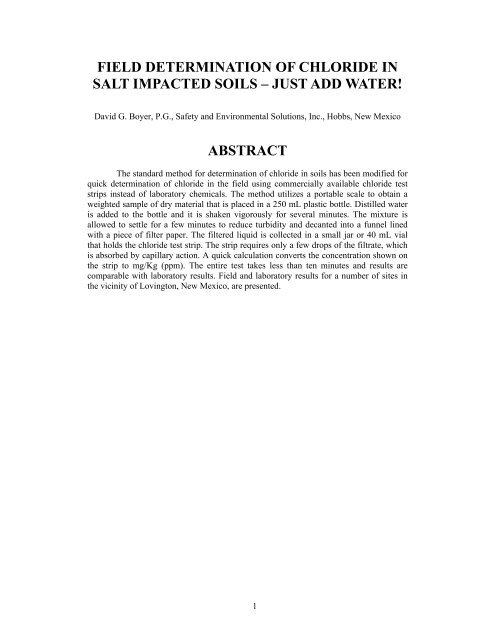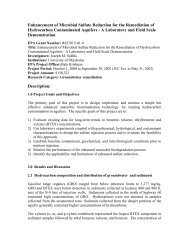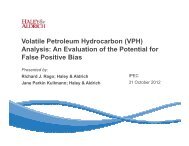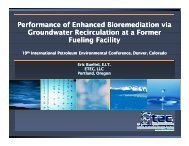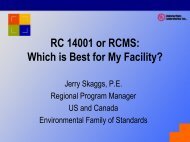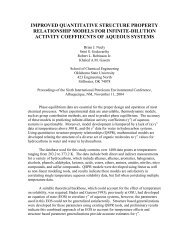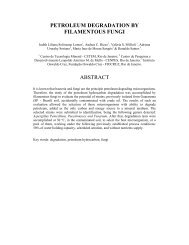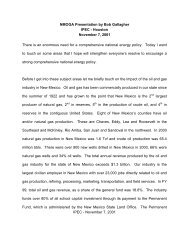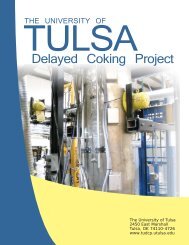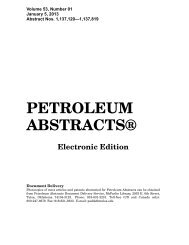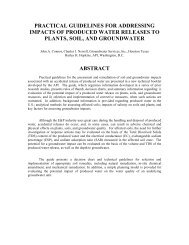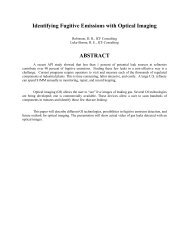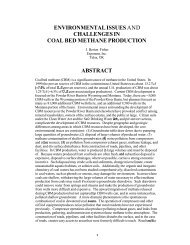field determination of chloride in salt impacted soils â just add ... - IPEC
field determination of chloride in salt impacted soils â just add ... - IPEC
field determination of chloride in salt impacted soils â just add ... - IPEC
You also want an ePaper? Increase the reach of your titles
YUMPU automatically turns print PDFs into web optimized ePapers that Google loves.
FIELD DETERMINATION OF CHLORIDE IN<br />
SALT IMPACTED SOILS – JUST ADD WATER!<br />
David G. Boyer, P.G., Safety and Environmental Solutions, Inc., Hobbs, New Mexico<br />
ABSTRACT<br />
The standard method for <strong>determ<strong>in</strong>ation</strong> <strong>of</strong> <strong>chloride</strong> <strong>in</strong> <strong>soils</strong> has been modified for<br />
quick <strong>determ<strong>in</strong>ation</strong> <strong>of</strong> <strong>chloride</strong> <strong>in</strong> the <strong>field</strong> us<strong>in</strong>g commercially available <strong>chloride</strong> test<br />
strips <strong>in</strong>stead <strong>of</strong> laboratory chemicals. The method utilizes a portable scale to obta<strong>in</strong> a<br />
weighted sample <strong>of</strong> dry material that is placed <strong>in</strong> a 250 mL plastic bottle. Distilled water<br />
is <strong>add</strong>ed to the bottle and it is shaken vigorously for several m<strong>in</strong>utes. The mixture is<br />
allowed to settle for a few m<strong>in</strong>utes to reduce turbidity and decanted <strong>in</strong>to a funnel l<strong>in</strong>ed<br />
with a piece <strong>of</strong> filter paper. The filtered liquid is collected <strong>in</strong> a small jar or 40 mL vial<br />
that holds the <strong>chloride</strong> test strip. The strip requires only a few drops <strong>of</strong> the filtrate, which<br />
is absorbed by capillary action. A quick calculation converts the concentration shown on<br />
the strip to mg/Kg (ppm). The entire test takes less than ten m<strong>in</strong>utes and results are<br />
comparable with laboratory results. Field and laboratory results for a number <strong>of</strong> sites <strong>in</strong><br />
the vic<strong>in</strong>ity <strong>of</strong> Lov<strong>in</strong>gton, New Mexico, are presented.<br />
1
INTRODUCTION<br />
Water produced concurrent with the extraction <strong>of</strong> crude oil or natural gas<br />
commonly conta<strong>in</strong>s chemical constituents with concentrations many times those found <strong>in</strong><br />
fresh water or even sea water. When <strong>in</strong>troduced to the surface environment through<br />
planned or unplanned releases produced water will adversely affect or destroy surface<br />
vegetation and can potentially contam<strong>in</strong>ate fresh groundwater supplies.<br />
In the past, common disposal <strong>of</strong> produced water was by placement <strong>in</strong> unl<strong>in</strong>ed<br />
surface impoundments or pits. For example, <strong>in</strong> rural Lea County New Mexico south <strong>of</strong><br />
Hobbs, approximately 29 million barrels <strong>of</strong> br<strong>in</strong>e were produced <strong>in</strong> 1955 with most<br />
disposal to unl<strong>in</strong>ed pits (1). Beg<strong>in</strong>n<strong>in</strong>g <strong>in</strong> the 1950’s, the state regulatory agency, the Oil<br />
Conservation Division, <strong>in</strong>stituted restrictions on disposal to unl<strong>in</strong>ed pits <strong>in</strong> southeastern<br />
New Mexico and today, with some exceptions, such disposal is prohibited statewide.<br />
Although surface disposal is generally prohibited, produced water still can<br />
impact the environment through accidental releases from leaks or breaks <strong>in</strong> flowl<strong>in</strong>es,<br />
tank failure, or from transportation accidents.<br />
Whether the concern is environmental effects from old disposal pits or from<br />
accidental releases, it is important to del<strong>in</strong>eate the area affected to assess impacts to<br />
surface resources and the potential for groundwater contam<strong>in</strong>ation. Follow<strong>in</strong>g such<br />
evaluation, the <strong>in</strong>formation collected is used as a basis for decision mak<strong>in</strong>g for physical<br />
clean up or to allow risk-based closure <strong>of</strong> the pit or spill location.<br />
Aside from obvious visible surface impacts such as dead vegetation or <strong>salt</strong><br />
deposits, del<strong>in</strong>eation <strong>of</strong> <strong>chloride</strong> impacts from produced water can be difficult without<br />
laboratory analytical test<strong>in</strong>g. Some test kits are available that use reagent chemicals such<br />
as silver nitrate and require mix<strong>in</strong>g and titration to determ<strong>in</strong>e <strong>chloride</strong> concentration <strong>in</strong><br />
the solution. Such kits are difficult to use <strong>in</strong> the <strong>field</strong> for <strong>chloride</strong> <strong>determ<strong>in</strong>ation</strong> <strong>in</strong> water,<br />
let alone soil.<br />
Recently, the Hach® Company has produced two <strong>chloride</strong> test strips (Quantab®<br />
High and Low Range) that allow test<strong>in</strong>g <strong>of</strong> the <strong>chloride</strong> concentration <strong>in</strong> water by merely<br />
dipp<strong>in</strong>g a strip <strong>in</strong> water and wait<strong>in</strong>g a few m<strong>in</strong>utes for capillary action to saturate it.<br />
Follow<strong>in</strong>g saturation, the strip is read and the correspond<strong>in</strong>g <strong>chloride</strong> concentration is<br />
found us<strong>in</strong>g a chart pr<strong>in</strong>ted on the bottle. The method has been adapted to enable<br />
environmental personnel to quickly and <strong>in</strong>expensively determ<strong>in</strong>e <strong>chloride</strong> concentration<br />
<strong>in</strong> soil <strong>in</strong> the <strong>field</strong> us<strong>in</strong>g readily available pieces <strong>of</strong> equipment.<br />
2
PROCEDURE DESCRIPTION<br />
A generalized description <strong>of</strong> the procedure is provided <strong>in</strong> this section. A detailed<br />
list <strong>of</strong> <strong>in</strong>structions, suitable for provid<strong>in</strong>g to <strong>field</strong> technicians, is provided <strong>in</strong> the Appendix<br />
at the end <strong>of</strong> this paper.<br />
One method by which soluble <strong>salt</strong>s <strong>in</strong> <strong>soils</strong> such as <strong>chloride</strong> can be determ<strong>in</strong>ed or<br />
estimated is from measurements made on aqueous extracts <strong>of</strong> soil samples (2). Other<br />
methods may be more useful for <strong>determ<strong>in</strong>ation</strong> <strong>of</strong> soil sal<strong>in</strong>ity and its relation to <strong>field</strong> soil<br />
water content necessary for crop growth, but are not relevant <strong>in</strong> this <strong>in</strong>stance. Aqueous<br />
extracts on the order <strong>of</strong> 1:4 or 1:5 weight to volume commonly are used by analytical<br />
laboratories for <strong>chloride</strong> <strong>determ<strong>in</strong>ation</strong> <strong>in</strong> soil. The procedure described <strong>in</strong> this paper uses<br />
a 1:4 extract.<br />
Necessary Equipment<br />
A m<strong>in</strong>imum <strong>of</strong> special equipment is needed to perform the <strong>field</strong> <strong>determ<strong>in</strong>ation</strong> <strong>of</strong><br />
<strong>chloride</strong>. A sta<strong>in</strong>less steel spoon and mix<strong>in</strong>g bowl are commonly used <strong>in</strong> collect<strong>in</strong>g soil<br />
samples. Additional items are a portable battery operated scale (0 to 200 gram range),<br />
disposable weigh<strong>in</strong>g dishes, a 250 mL wide mouth plastic bottle, a small graduated<br />
cyl<strong>in</strong>der, a plastic funnel, filter paper, a small jar or 40 mL vials, distilled water and the<br />
Hach Quantabs®. The Quantabs come <strong>in</strong> high and low range strips with <strong>chloride</strong><br />
concentration rang<strong>in</strong>g from 300 to 6000 ppm and 30 to 600 ppm, respectively. All<br />
reusable equipment should be clean before use; the funnel and small jar or 40 mL vials<br />
must be completely dry. The equipment is carried <strong>in</strong> a foam-l<strong>in</strong>ed hard plastic case (e.g. a<br />
Pelican Case®) for protection aga<strong>in</strong>st vibration and moisture.<br />
Sample Preparation<br />
Samples are commonly collected from the soil surface or from boreholes drilled<br />
with a hollow stem auger equipped with a split-spoon or core barrel sampler. The sample<br />
is placed <strong>in</strong> a mix<strong>in</strong>g bowl and organic matter such as roots discarded. Rock and gravel<br />
larger than small pebbles are commonly removed. Homogenize the sample by thoroughly<br />
mix<strong>in</strong>g it prior to weigh<strong>in</strong>g or placement <strong>in</strong> a sample jar (if laboratory analysis is to be<br />
performed). To the extent possible the material placed <strong>in</strong> a sample jar for laboratory<br />
analysis should be as much like the sample selected for <strong>field</strong> <strong>determ<strong>in</strong>ation</strong>. In <strong>add</strong>ition<br />
coord<strong>in</strong>ate with the analytical laboratory to ascerta<strong>in</strong> if they have a standard protocol for<br />
selection <strong>of</strong> small volume samples (e.g. a maximum size <strong>of</strong> pebbles <strong>in</strong> the sample).<br />
A tared weigh<strong>in</strong>g dish is placed on the scale and 25 grams <strong>of</strong> the sample is<br />
weighed and then placed <strong>in</strong> the plastic bottle. 100 mL <strong>of</strong> water is <strong>add</strong>ed and the mixture<br />
shaken for one m<strong>in</strong>ute or longer. Allow the sample mixture to settle for a short time<br />
period so that heavy particles drop out. Fold a piece <strong>of</strong> filter paper <strong>in</strong>to quarters and place<br />
<strong>in</strong> the funnel. Place the funnel <strong>in</strong> the small jar or 40-mL vial together with a Quantab®<br />
strip. Decant the sample <strong>in</strong>to the folded filter paper and allow approximately ½ <strong>in</strong>ch <strong>of</strong><br />
clear filtrate to accumulate <strong>in</strong> the vial before remov<strong>in</strong>g the funnel. Turbid solutions <strong>in</strong> the<br />
vial will clog the capillary pores and cause very slow or <strong>in</strong>complete reactions.<br />
3
Chloride Determ<strong>in</strong>ation<br />
When a Quantab® strip is placed <strong>in</strong> an aqueous solution, fluid rises up the strip<br />
by capillary action until the strip is completely saturated. The strip conta<strong>in</strong>s silver ions,<br />
which comb<strong>in</strong>e with <strong>chloride</strong> <strong>in</strong> the sample to form a white column <strong>of</strong> <strong>chloride</strong>. A<br />
moisture sensitive yellow str<strong>in</strong>g across the top <strong>of</strong> the tab turns blue-black when saturated<br />
and <strong>in</strong>dicates completion <strong>of</strong> capillary action and the reaction. The length <strong>of</strong> the white<br />
silver <strong>chloride</strong> column on the strip is proportional to the <strong>chloride</strong> concentration.<br />
Follow<strong>in</strong>g saturation, the value on the tab is read and the chart on the back <strong>of</strong> the<br />
appropriate bottle used to get the <strong>chloride</strong> value for the strip. Each Quantab® lot is<br />
calibrated <strong>in</strong>dependently; the <strong>chloride</strong> concentration chart on the bottle from which the<br />
strip was removed is used as values may differ from those <strong>of</strong> a previous bottle. Multiply<br />
the chart value by four (4) to get the <strong>chloride</strong> concentration <strong>in</strong> soil <strong>in</strong> ppm (mg/Kg).<br />
Depend<strong>in</strong>g on the time taken to shake the sample, decant and filter the liquid, and the<br />
turbidity <strong>of</strong> the filtrate, the time required to conduct a s<strong>in</strong>gle test is usually from five to<br />
ten m<strong>in</strong>utes.<br />
COMPARISON WITH LABORATORY RESULTS<br />
The <strong>field</strong> results are compared with laboratory results for four sites located <strong>in</strong> the<br />
vic<strong>in</strong>ity <strong>of</strong> Lov<strong>in</strong>gton, New Mexico (Tables 1 through 4). The geologic sett<strong>in</strong>g is the<br />
Tertiary Ogallala formation which is chiefly a calcareous, unconsolidated sand but with<br />
some zones <strong>of</strong> sandstone <strong>of</strong> vary<strong>in</strong>g hardness (1). In the upper ten to twenty feet <strong>in</strong> the<br />
study areas the formation is capped by a layer <strong>of</strong> caliche <strong>of</strong> vary<strong>in</strong>g thickness and density.<br />
The borehole splitspoon/core barrel samples taken near the surface usually are<br />
quite rocky and prior to test<strong>in</strong>g the samples must be prepared as described above to<br />
remove pieces <strong>of</strong> caliche and sandstone rock as big a 3-<strong>in</strong>. <strong>in</strong> diameter. Notwithstand<strong>in</strong>g<br />
sample preparation problems, the laboratory results show good agreement with the <strong>field</strong><br />
tests.<br />
Table 5 presents the results <strong>of</strong> the comparison for the 62 samples tested.<br />
Twenty-three samples (37 percent) <strong>of</strong> the <strong>field</strong> results were with<strong>in</strong> 0 to 10 percent <strong>of</strong> the<br />
laboratory results and another 14 samples (23 percent) were between 11 and 20 percent.<br />
A total <strong>of</strong> 37 <strong>field</strong> samples (60 percent) were with<strong>in</strong> 20 percent <strong>of</strong> the laboratory value.<br />
Only 4 <strong>field</strong> samples (6 percent) exhibited greater than 50 percent difference from the<br />
laboratory result. The highest percent difference between <strong>field</strong> and laboratory test results<br />
was 63 percent.<br />
Unlike water samples, soil samples are rarely homogenous with vary<strong>in</strong>g particle<br />
size and with soluble constituent concentrations dependent on the <strong>in</strong>itial soil water<br />
concentration, the pathway followed <strong>in</strong> the porous medium, and the amount <strong>of</strong> sorption<br />
on the soil particles. Given this <strong>in</strong>nate variability, which exists even with<strong>in</strong> a s<strong>in</strong>gle soil<br />
sample, agreement between <strong>field</strong> and laboratory results is consistent and certa<strong>in</strong>ly<br />
acceptable for purposes <strong>of</strong> <strong>field</strong> del<strong>in</strong>eation <strong>of</strong> <strong>chloride</strong> impacts from the types <strong>of</strong> releases<br />
described <strong>in</strong> this paper.<br />
4
COST CONSIDERATIONS<br />
The cost per <strong>chloride</strong> test is m<strong>in</strong>imal. A bottle <strong>of</strong> 40 Quantabs® available from<br />
the Hach Company is currently priced at $32; therefore, each strip costs $0.80. The scale<br />
used to weigh the soil samples is an Ohaus model CS200 available from<br />
www.scalesonl<strong>in</strong>e.com at a cost <strong>of</strong> $55. The other test equipment is available from<br />
laboratory supply companies at m<strong>in</strong>imal cost.<br />
SUMMARY<br />
A quick and <strong>in</strong>expensive test for <strong>field</strong> <strong>determ<strong>in</strong>ation</strong> <strong>of</strong> <strong>chloride</strong> <strong>in</strong> <strong>salt</strong> <strong>impacted</strong><br />
<strong>soils</strong> has been developed and has proven to be very useful <strong>in</strong> the del<strong>in</strong>eation <strong>of</strong> produced<br />
water releases from oil and gas operations. The test requires a m<strong>in</strong>imum <strong>of</strong> equipment to<br />
perform and does not require the use <strong>of</strong> chemicals <strong>in</strong> the <strong>field</strong>, only distilled water. The<br />
test can be completed with<strong>in</strong> five to ten m<strong>in</strong>utes depend<strong>in</strong>g on the turbidity <strong>of</strong> the<br />
aqueous extract and the time required for settl<strong>in</strong>g and filter<strong>in</strong>g the sample. Results from<br />
the test are quite comparable with results from laboratory tests performed on the same<br />
sample. Field results for sixty percent <strong>of</strong> the samples exam<strong>in</strong>ed were with<strong>in</strong> twenty<br />
percent <strong>of</strong> the laboratory results. Although the cost per test is very <strong>in</strong>expensive, the real<br />
value <strong>of</strong> the test is the time saved on site by be<strong>in</strong>g able to directly del<strong>in</strong>eate horizontal<br />
and vertical extent <strong>of</strong> a release without the <strong>add</strong>ed expense <strong>of</strong> hav<strong>in</strong>g outside contractors<br />
return to a site for <strong>add</strong>itional <strong>in</strong>vestigation.<br />
REFERENCES CITED<br />
1. Nicholson, A., Jr. and Clebsch, A. Jr., Geology and Ground-Water Conditions <strong>in</strong><br />
Southern Lea County, New Mexico, Ground-Water Report 6, State Bureau <strong>of</strong><br />
M<strong>in</strong>es and M<strong>in</strong>eral Resources, New Mexico Institute <strong>of</strong> M<strong>in</strong><strong>in</strong>g and Technology,<br />
Socorro, New Mexico (1961).<br />
2. Rhoades, J.D., “Soluble Salts,” <strong>in</strong> Methods <strong>of</strong> Soil Analysis, Part 2. Chemical<br />
and Microbiological Properties, Chapter 10, American Society <strong>of</strong> Agronomy −<br />
Soil Science Society <strong>of</strong> America Agronomy Monograph no. 9, Madison,<br />
Wiscons<strong>in</strong> (2 nd Edition, 1982).<br />
3. Franson, M. H. (editor), Standard Methods for the Exam<strong>in</strong>ation <strong>of</strong> Water and<br />
Wastewater, Seventeenth Edition, American Public Health Association,<br />
Wash<strong>in</strong>gton, DC (1989).<br />
5
Table 1. Site 1, <strong>salt</strong> water l<strong>in</strong>e leak, northeast <strong>of</strong> Lov<strong>in</strong>gton, NM, north <strong>of</strong> US Hwy 82<br />
Sample Location<br />
Depth<br />
(ft.)<br />
Strip Range<br />
(high or<br />
low)<br />
Field<br />
Test<br />
(ppm)<br />
Laboratory<br />
Analysis<br />
(mg/Kg)<br />
Percent<br />
Difference from<br />
Lab<br />
BH-1 5 H 5,144 8,397 -38.7<br />
BH-1 10 H 6,156 5,918 4.0<br />
BH-1 15 H 3,856 3,679 4.8<br />
BH-1R 18 H 5,632 6,958 -19.1<br />
BH-1R (duplicate) 18 H 6,156 6,958 -11.5<br />
BH-1R 22-24 L 372 496 -25.0<br />
BH-2 5 H 2,800 3,759 -25.5<br />
BH-2 10 L 1,816 2,719 -33.2<br />
BH-2 15 L
Table 3. Site 3, leaky concrete-l<strong>in</strong>ed hold<strong>in</strong>g pond at <strong>salt</strong> water disposal facility,<br />
northeast <strong>of</strong> Lov<strong>in</strong>gton, NM, south <strong>of</strong> US Hwy 82.<br />
Sample<br />
Location<br />
Depth (ft.)<br />
Strip Range<br />
(high or low)<br />
Field Test<br />
(ppm)<br />
Laboratory<br />
Analysis<br />
(mg/Kg)<br />
Percent<br />
Difference<br />
from Lab<br />
BH-1 5 L 680 976 -30.3<br />
BH-1 10 L 1,384 1,456 -4.9<br />
BH-1 15 L 636 736 -13.6<br />
BH-1 20 L 212 528 -59.8<br />
BH-2 10 L 280 576 -51.4<br />
BH-2 15 L 436 720 -39.4<br />
BH-2 20 L 960 1,136 -15.5<br />
BH-2 25 L 1,200 2,143 -44.0<br />
BH-2 30 L 1,956 2,399 -18.5<br />
BH-2 35 H 3,292 3,538 -7.0<br />
BH-2 40 H 2,326 2,799 -16.9<br />
BH-2 45 H 2,108 2,623 -19.6<br />
BH-3 15 L 1,592 976 63.1<br />
BH-3 20 L 1,036 1,120 -7.5<br />
BH-3 25 L 528 576 -8.3<br />
BH-3 30 L 280 400 -30.0<br />
BH-3 35 L 692 544 27.2<br />
BH-3 40 L 392 368 6.5<br />
BH-3 45 L 280 240 16.7<br />
Table note: Chloride analysis us<strong>in</strong>g Standard Methods 4500-Cl - B.<br />
7
Table 4. Site 4, tank overflows at <strong>salt</strong> water disposal facility, southeast <strong>of</strong> Lov<strong>in</strong>gton,<br />
NM, west <strong>of</strong> NM Hwy 18.<br />
Sample<br />
Location<br />
Depth (ft.)<br />
Strip Range<br />
(high or low)<br />
Field Test<br />
(ppm)<br />
Laboratory<br />
Analysis<br />
(mg/Kg)<br />
Percent<br />
Difference<br />
from Lab<br />
BH-1 17-18 H 2,208 1,504 46.8<br />
BH-1 24-25 H 1,944 1,344 44.6<br />
BH-1 30 L 492 592 -16.9<br />
BH-1 35 L 204 272 -25.0<br />
BH-2 15 H 1,052 912 15.4<br />
BH-2 19-20 L 824 928 -11.2<br />
BH-2 24-25 L 368 464 -20.7<br />
BH-2 30 L 148 208 -28.8<br />
BH-3 10 L 492 496 -0.8<br />
BH-3 15 L 700 720 -2.8<br />
BH-3 20 L 540 464 16.4<br />
BH-3 25 L 492 544 -9.6<br />
BH-3 30 L 328 496 -33.9<br />
BH-3 35 L 588 640 -8.1<br />
BH-3 39-40 L 1,620 1,664 -2.6<br />
BH-3 45 L 1,620 1,615 0.3<br />
BH-3 55 L 1,620 1,711 -5.3<br />
BH-3 60 L 2,020 1,951 3.5<br />
Table note: Chloride analysis us<strong>in</strong>g Standard Methods 4500-Cl - B.<br />
Table 5. Summary table show<strong>in</strong>g relationship <strong>of</strong> <strong>field</strong> sample results to laboratory<br />
analyses.<br />
Percent Difference from Laboratory Result (±), n=62<br />
0-10% 11-20% 21-30% 31-40% 41-50% >50%<br />
23 14 11 5 5 4<br />
37% 23% 18% 8% 8% 6%<br />
8
Figure 1. Equipment setup for <strong>field</strong> <strong>determ<strong>in</strong>ation</strong> <strong>of</strong> <strong>chloride</strong>s <strong>in</strong> <strong>soils</strong>.<br />
Figure 2. Soil preparation and weigh<strong>in</strong>g <strong>of</strong> soil sample for <strong>chloride</strong> <strong>determ<strong>in</strong>ation</strong>.<br />
9
Figure 3. Hach® Quantab® test strips used for <strong>field</strong> <strong>determ<strong>in</strong>ation</strong> <strong>of</strong> <strong>chloride</strong> <strong>in</strong> <strong>soils</strong>.<br />
Figure 4. Hach® Quantab® <strong>chloride</strong> test strip at completion <strong>of</strong> <strong>chloride</strong> <strong>field</strong> test.<br />
10
APPENDIX<br />
Procedure for Field Determ<strong>in</strong>ation <strong>of</strong> Chloride <strong>in</strong> Soil<br />
Equipment:<br />
4-oz. sampl<strong>in</strong>g jars, spoon, sta<strong>in</strong>less steel mix<strong>in</strong>g bowl, 250 mL plastic wide<br />
mouth plastic bottle, 25 mL graduated cyl<strong>in</strong>der, scale, disposable weigh<strong>in</strong>g<br />
dishes, funnel, filter paper (Whatman® #4 Qualitative 125 mm diameter circles<br />
or equivalent), 40 mL vials, Hach Quantab® strips (low and high range), distilled<br />
water. Prior to use, all equipment should be clean and dry.<br />
Sampl<strong>in</strong>g and preparation procedure:<br />
Collect a soil sample from the surface or from a splitspoon/core barrel and place<br />
<strong>in</strong> a mix<strong>in</strong>g bowl and homogenize. Remove rocks and gravel larger than small<br />
pebbles. Weigh 25 grams <strong>of</strong> soil and place <strong>in</strong> the wide-mouth bottle. For a 1:4<br />
weight to volume dilution, <strong>add</strong> 100 mL <strong>of</strong> distilled water to the bottle. Shake<br />
vigorously for several m<strong>in</strong>utes (no longer than 5 m<strong>in</strong>utes). Let the sample settle<br />
for a m<strong>in</strong>ute or two to allow heavy particles to drop out. Fold and place filter <strong>in</strong><br />
the funnel and decant sample <strong>in</strong>to the filter. Collect the filtrate <strong>in</strong> a clean 40 mL<br />
vial. Only about ½ <strong>in</strong>ch <strong>of</strong> clear filtrate <strong>in</strong> the vial is needed for the procedure.<br />
Chloride Determ<strong>in</strong>ation:<br />
Place a high or low range Quantab® strip <strong>in</strong> the vial (replace cap on Quantabs<br />
bottle to prevent moisture from degrad<strong>in</strong>g the tabs). Wait until the yellow strip at<br />
the top <strong>of</strong> the tab turns blue-black. Read the value on the tabs and use the chart<br />
on the back <strong>of</strong> the appropriate bottle to get the <strong>chloride</strong> value for each strip. Each<br />
Quantab® lot is calibrated <strong>in</strong>dependently, so use the chart on the bottle where<br />
you removed the strip; the <strong>chloride</strong> concentration chart may differ from a<br />
previous bottle. Multiply the chart value by four (4) to get the concentration <strong>of</strong><br />
<strong>chloride</strong> <strong>in</strong> soil <strong>in</strong> ppm (mg/Kg). Record the value <strong>in</strong> <strong>field</strong> book.<br />
For laboratory analysis, place sample from mix<strong>in</strong>g bowl <strong>in</strong> a 4-oz jar and<br />
transport to the laboratory with a cha<strong>in</strong>-<strong>of</strong>-custody form.<br />
11


